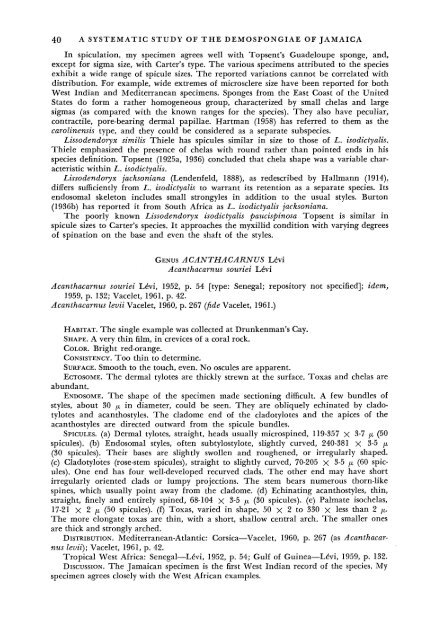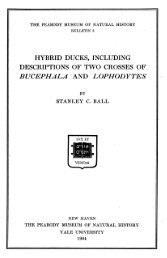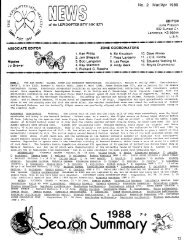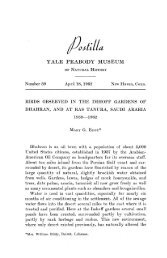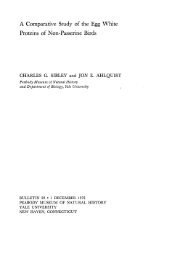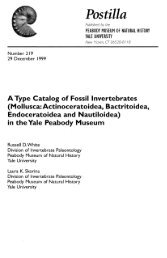Bulletin 20 - Peabody Museum of Natural History - Yale University
Bulletin 20 - Peabody Museum of Natural History - Yale University
Bulletin 20 - Peabody Museum of Natural History - Yale University
You also want an ePaper? Increase the reach of your titles
YUMPU automatically turns print PDFs into web optimized ePapers that Google loves.
40 A SYSTEMATIC STUDY OF THE DEMOSPONGIAE OF JAMAICA<br />
In spiculation, my specimen agrees well with Topsent's Guadeloupe sponge, and,<br />
except for sigma size, with Carter's type. The various specimens attributed to the species<br />
exhibit a wide range <strong>of</strong> spicule sizes. The reported variations cannot be correlated with<br />
distribution. For example, wide extremes <strong>of</strong> microsclere size have been reported for both<br />
West Indian and Mediterranean specimens. Sponges from the East Coast <strong>of</strong> the United<br />
States do form a rather homogeneous group, characterized by small chelas and large<br />
sigmas (as compared with the known ranges for the species). They also have peculiar,<br />
contractile, pore-bearing dermal papillae. Hartman (1958) has referred to them as the<br />
carolinensis type, and they could be considered as a separate subspecies.<br />
Lissodendoryx similis Thiele has spicules similar in size to those <strong>of</strong> L. isodictyalis.<br />
Thiele emphasized the presence <strong>of</strong> chelas with round rather than pointed ends in his<br />
species definition. Topsent (1925a, 1936) concluded that chela shape was a variable characteristic<br />
within L. isodictyalis.<br />
Lissodendoryx jacksoniana (Lendenfeld, 1888), as redescribed by Hallmann (1914),<br />
differs sufficiently from L. isodictyalis to warrant its retention as a separate species. Its<br />
endosomal skeleton includes small strongyles in addition to the usual styles. Burton<br />
(1936b) has reported it from South Africa as L. isodictyalis jacksoniana.<br />
The poorly known Lissodendoryx isodictyalis paucispinosa Topsent is similar in<br />
spicule sizes to Carter's species. It approaches the myxillid condition with varying degrees<br />
<strong>of</strong> spination on the base and even the shaft <strong>of</strong> the styles.<br />
GENUS ACANTHACARNUS Levi<br />
Acanthacarnus souriei Levi<br />
Acanthacarnus souriei Levi, 1952, p. 54 [type: Senegal; repository not specified]; idem,<br />
1959, p. 132; Vacelet, 1961, p. 42.<br />
Acanthacarnus levii Vacelet, 1960, p. 267 (fide Vacelet, 1961.)<br />
HABITAT. The single example was collected at Drunkenman's Cay.<br />
SHAPE. A very thin film, in crevices <strong>of</strong> a coral rock.<br />
COLOR. Bright red-orange.<br />
CONSISTENCY. TOO thin to determine.<br />
SURFACE. Smooth to the touch, even. No oscules are apparent.<br />
ECTOSOME. The dermal tylotes are thickly strewn at the surface. Toxas and chelas are<br />
abundant.<br />
ENDOSOME. The shape <strong>of</strong> the specimen made sectioning difficult. A few bundles <strong>of</strong><br />
styles, about 30 fx in diameter, could be seen. They are obliquely echinated by cladotylotes<br />
and acanthostyles. The cladome end <strong>of</strong> the cladotylotes and the apices <strong>of</strong> the<br />
acanthostyles are directed outward from the spicule bundles.<br />
SPICULES, (a) Dermal tylotes, straight, heads usually microspined, 119-357 X 3-7 /x (50<br />
spicules), (b) Endosomal styles, <strong>of</strong>ten subtylostylote, slightly curved, 240-381 X 3-5 xi<br />
(30 spicules). Their bases are slightly swollen and roughened, or irregularly shaped.<br />
(c) Cladotylotes (rose-stem spicules), straight to slightly curved, 70-<strong>20</strong>5 x 3-5 /x (60 spicules).<br />
One end has four well-developed recurved clads. The other end may have short<br />
irregularly oriented clads or lumpy projections. The stem bears numerous thorn-like<br />
spines, which usually point away from the cladome. (d) Echinating acanthostyles, thin,<br />
straight, finely and entirely spined, 68-104 x 3-5 ^ (30 spicules), (e) Palmate isochelas,<br />
17-21 X 2 /a (50 spicules), (f) Toxas, varied in shape, 50 X 2 to 330 X less than 2 /x.<br />
The more elongate toxas are thin, with a short, shallow central arch. The smaller ones<br />
are thick and strongly arched.<br />
DISTRIBUTION. Mediterranean-Atlantic: Corsica—Vacelet, 1960, p. 267 (as Acanthacarnus<br />
levii); Vacelet, 1961, p. 42.<br />
Tropical West Africa: Senegal—Levi, 1952, p. 54; Gulf <strong>of</strong> Guinea—Levi, 1959, p. 132.<br />
DISCUSSION. The Jamaican specimen is the first West Indian record <strong>of</strong> the species. My<br />
specimen agrees closely with the West African examples.


